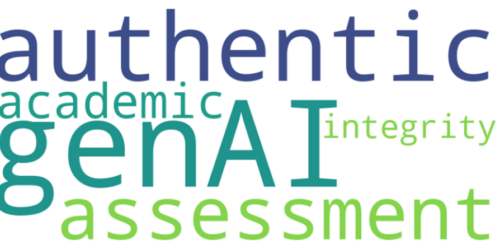
Academic Integrity and Assessment in the Age of Generative Artificial Intelligence (GenAI)
A fair and accurate assessment provides evidence of a student’s learning under their own cognitive efforts. Concerns around academic integrity, however, can cast doubt on an assessment: Is this the student’s work? Is this the work a true representation of the student’s learning?
The growing and widespread availability of generative artificial intelligence (genAI) since fall 2022 has intensified questions around the originality of student work and the fairness and accuracy of assessments. Since genAI detection tools are unreliable and biased, it is impossible to differentiate with confidence or consistency between human- and machine-generated outputs. Moreover, genAI is quickly becoming embedded across industries and sectors, meaning work-ready graduates must be critical, ethical users of these technologies (Eaton, 2023). As faculty, we are understandably asking new questions about what we are assessing and why.
This Hub post explores the topic of academic integrity and assessment in two ways. First, it invites you to reflect on your current approach to academic integrity and consider what’s working and where you see challenges in terms of assessment. Second, this post offers six strategies to promote academic integrity and ensure students provide evidence of learning outcomes in assessments.
Reflect on your current approach
Some prompts to get you thinking:
- Consider what you are already doing to promote academic integrity in assessment. Make a jot list of strategies you are already using.
- In your view, how effective are these strategies in supporting academic integrity in your assessments? Consider the efficacy of current strategies given the ubiquity of genAI. Assign each strategy an effectiveness rating on a scale from 1 to 10, with 1 being “not effective at all” and 10 being “highly effective.”
- What do your students understand about academic integrity when they arrive in your classroom? How do they demonstrate that understanding? Where are there gaps in understanding?
- What do you understand about your students’ use of genAI in completing assessments?
- Will your students use genAI in the workplace? In what ways?
Six strategies to promote academic integrity in assessment
- Communicate expectations around academic integrity, verbally and in writing, when you assign the assessment. Clarify that students must submit their own work because it is evidence of their learning in a course leading to a post-secondary credential. You could also explore the importance of learning skills and knowledge that students will be required to demonstrate in the workplace. Such expectations are best communicated interpersonally, in class or recorded in a video, rather than simply posted as an announcement on eConestoga or as a line of text in assignment instructions.
- Expectations should include parameters for genAI use in assessments in your course. Is the technology allowed, encouraged, forbidden, discouraged? Which platforms? Under what conditions? For what assessment tasks and why?
- Consider visiting Artificial Intelligence (AI) Assessment Statements for Students for examples.
- Provide instruction on expected citation practices and the reasons you expect students to use citations. Again, instructions should be provided in writing and verbally. Citing Artificial Intelligence (AI) provides example communication for you to use with your students. Offer templates and models to demonstrate what citations look like in a sample (unrelated) assignment. Give space for students to explore confusion around citation practices and welcome their questions. Allow space for trial and error by, for example, not penalizing students on errors in citations on early assessments or offering space to practice and receive feedback. Approach citation as an evolving practice.
- Use a scaffolded approach to break down an assessment into smaller tasks, which can make an assessment less intimidating for students. As the first step in the scaffold, check in with students to determine their baseline knowledge and comfort with the topic or materials. You might need to adjust your approach to the assessment to bring students to a similar baseline. The goal is to determine students’ levels and adjust accordingly from the outset.
- Offer students several no-stakes opportunities to practice on an assessment and receive informal feedback. Encouraging trial and error without penalty can discourage last-minute decisions to use unauthorized assistance in completing an assignment. Feedback provided during practice assessments can also clarify student questions and give valuable formative input so students can improve their work.
- Ask students to document their process as part of the assessment. Provide instructions on what you expect students to document as part of their process, how they should document it, and why. For example, does the assessment involve drafts? Is there a proposal stage? Should students track their work in logs or process journals? If it’s a group assessment, is there a shared document you can view as the project develops? Advise students on how you will provide feedback on their work in process and your expectations on how they will use this feedback.
- Tie assessments to course-specific material and contexts, such as readings, discussions, scenarios, and peer presentations. As appropriate to level and learning outcomes, ask students to reflect on and integrate concepts and materials from across the course, combining diverse ideas in a single assessment task. Ask students to choose from a list of options or topics in completing an assessment and have them provide a short reflection on how they chose. Were they driven by interest? Pragmatic considerations?
As you continue to refine your approach to academic integrity in assessment, consider that the more students are exposed to the ethical, critical use of genAI, the less likely they are to use these technologies to commit academic misconduct (Foltynek et al., 2023, p. 3). Transparency and training are keys to prevention.
References
Eaton, S. E. (2023, July 25). Using Generative AI Ethically: Teaching, Learning, and Assessing in a Postplagiarism Era [Invited presentation]. Ontario Universities Council on eLearning (OUCeL) Summer Institute, Ontario, Canada [Online].
Foltynek, T. et al. (2023). ENAI Recommendations on the ethical use of Artificial Intelligence in Education. International Journal for Educational Integrity, 19:12, pp. 1-4.






